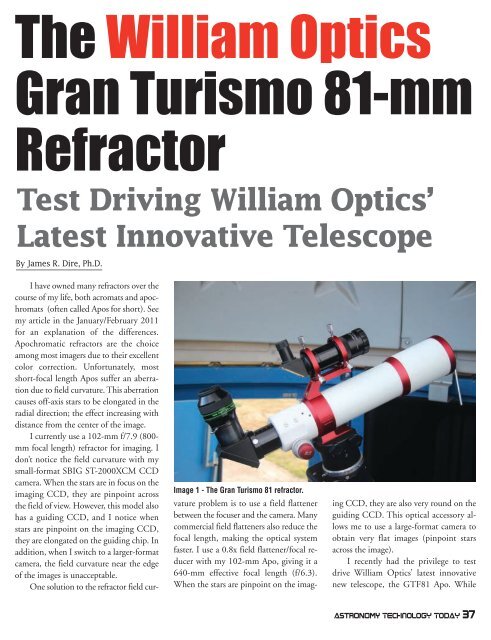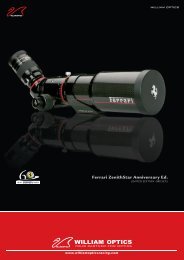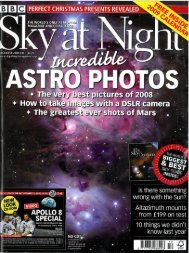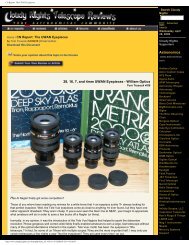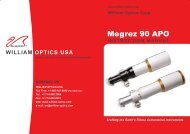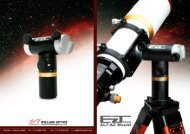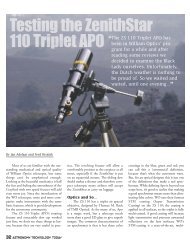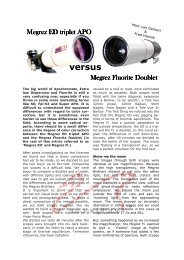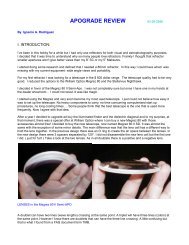WO Gran Turismo 81mm Reviews(PDF File) - William Optics
WO Gran Turismo 81mm Reviews(PDF File) - William Optics
WO Gran Turismo 81mm Reviews(PDF File) - William Optics
Create successful ePaper yourself
Turn your PDF publications into a flip-book with our unique Google optimized e-Paper software.
The <strong>William</strong> <strong>Optics</strong><br />
<strong>Gran</strong> <strong>Turismo</strong> 81-mm<br />
Refractor<br />
Test Driving <strong>William</strong> <strong>Optics</strong>’<br />
Latest Innovative Telescope<br />
By James R. Dire, Ph.D.<br />
I have owned many refractors over the<br />
course of my life, both acromats and apochromats<br />
(often called Apos for short). See<br />
my article in the January/February 2011<br />
for an explanation of the differences.<br />
Apochromatic refractors are the choice<br />
among most imagers due to their excellent<br />
color correction. Unfortunately, most<br />
short-focal length Apos suffer an aberration<br />
due to field curvature. This aberration<br />
causes off-axis stars to be elongated in the<br />
radial direction; the effect increasing with<br />
distance from the center of the image.<br />
I currently use a 102-mm f/7.9 (800-<br />
mm focal length) refractor for imaging. I<br />
don’t notice the field curvature with my<br />
small-format SBIG ST-2000XCM CCD<br />
camera. When the stars are in focus on the<br />
imaging CCD, they are pinpoint across<br />
the field of view. However, this model also<br />
has a guiding CCD, and I notice when<br />
stars are pinpoint on the imaging CCD,<br />
they are elongated on the guiding chip. In<br />
addition, when I switch to a larger-format<br />
camera, the field curvature near the edge<br />
ofthe images is unacceptable.<br />
One solution to the refractor field cur-<br />
Image 1 - The <strong>Gran</strong> <strong>Turismo</strong> 81 refractor.<br />
vature problem is to use a field flattener<br />
between the focuser and the camera. Many<br />
commercial field flatteners also reduce the<br />
focal length, making the optical system<br />
faster. I use a 0.8x field flattener/focal reducer<br />
with my 102-mm Apo, giving it a<br />
640-mm effective focal length (f/6.3).<br />
When the stars are pinpoint on the imaging<br />
CCD, they are also very round on the<br />
guiding CCD. This optical accessory allows<br />
me to use a large-format camera to<br />
obtain very flat images (pinpoint stars<br />
across the image).<br />
I recently had the privilege to test<br />
drive <strong>William</strong> <strong>Optics</strong>’ latest innovative<br />
new telescope, the GTF81 Apo. While<br />
Astronomy TECHNOLOGY TODAY 37
THE WILLIAM OPTICS GRAN TURISMO 81-MM REFRACTORS<br />
Image 2 - The left focus knob has a built-in analog thermomoter!<br />
most true Apos have a three lenses in the<br />
optical train, the <strong>Gran</strong> <strong>Turismo</strong> line oftelescopes<br />
have five optical elements. The objective<br />
is an 81-mm (3.2-inches) diameter<br />
optical air-spaced triplet containing highquality<br />
FPL-53 extra-low dispersion glass.<br />
The second group, located at the focuser<br />
end ofthe optical tube assemble, is an airspaced<br />
doublet containing ED glass that<br />
serves as a built-in field flattener. Each lens<br />
is fully multi-coated with a special superhigh<br />
transmission coating on all surfaces.<br />
The focal length is 478 mm creating a fast<br />
f/5.9 imaging system. The advantages of<br />
the built-in field flattener are it shortens<br />
the overall distance from the focuser to the<br />
camera and requires one less accessory to<br />
store in the equipment case and attach for<br />
each observing run.<br />
Image 1 shows the <strong>Gran</strong> <strong>Turismo</strong> 81.<br />
The optical tube assembly is beautifully<br />
crafted and made of aluminum. The tube<br />
is white with a metallic-red finish on the<br />
trim, clamshell ring, Vixen-style dovetail<br />
plate, tube cover, finder bracket and the focusing<br />
knob. The telescope does not come<br />
with a finder scope, diagonal, or any eyepieces,<br />
so they must be purchased separately.<br />
However, it does come with a 1.25<br />
inch-to-2 inch eyepiece adapter. The dovetail<br />
plate is tapped to accept a ¼-20 tripod<br />
screw. The finder bracket should hold<br />
most 50-mm finder scopes (the finder pictured<br />
in Image 1 is a 9x50 scope). The six<br />
38 Astronomy TECHNOLOGY TODAY
THE WILLIAM OPTICS GRAN TURISMO 81-MM REFRACTORS<br />
Image 3 - The nearly full moon taken with an SBIG ST-2000XCM CCD camera.<br />
alignment screws make it easy to adjust the<br />
finder parallel to the main telescope!<br />
The GTF81 is very compact. Its storage<br />
length is 17.3 inches (440 mm) and<br />
when the dew shield is extended it is still<br />
only 19 inches (484 mm) long. The OTA<br />
weighs just over 8 pounds (3.7 kilograms).<br />
The telescope comes with a great twospeed<br />
2-inch Crayford focuser with left<br />
and right focusing knobs and a 1:10 fine<br />
focusing knob on the right side. Two cool<br />
things I have never seen on a focuser before<br />
are a cover for the fine focusing knob<br />
to protect it during transport and an analog<br />
thermometer built into the left focusing<br />
knob (see Image 2) displaying the<br />
temperature in both Fahrenheit and Celsius!<br />
The drawtube has 3.15 inches (80<br />
mm) oftravel and is graduated to aid in<br />
returning to a focal position. Although the<br />
model I tested did not have it, the telescope<br />
can be ordered with a Digital Display<br />
Gauge.<br />
By loosening a locking screw on top<br />
of the assembly, the focuser assembly fully<br />
rotates 360 degrees. I found the rotation<br />
to work very smoothly, and rotation does<br />
not affect the focus. This is great for reframing<br />
images or looking for off-axis<br />
guide stars for imaging work. There is another<br />
locking screw beneath the focuser to<br />
keep it from slipping once a sharp focus<br />
has been achieved. This is the first telescope<br />
I have done CCD imaging with that<br />
tightening the focus locking screw did not<br />
slightly shift the focus!<br />
Visually, the telescope performed superbly.<br />
I tested the Apo’s color correction<br />
with viewing ofthe Moon and Venus and<br />
found it to be perfect. At low and high<br />
powers, stars were pinpoint across the field<br />
ofview. I viewed Saturn with my 5-mm<br />
Nagler eyepiece (128x). The rings were in<br />
their splendor with the Cassini Divisions<br />
easily seen.<br />
With only 3.2 inches ofaperture, this<br />
is not a telescope for deep-space observing.<br />
It will perform well viewing Andromeda<br />
Galaxy and its satellites, the Orion Nebula,<br />
and brighter star clusters. But it doesn’t<br />
have enough light gathering power or<br />
focal length to significantly resolve globular<br />
clusters or to view fainter nebulae or<br />
galaxies.<br />
This telescope is designed to be a<br />
small, light-weight imaging instrument.<br />
The 640-mm focal length will capture<br />
Astronomy TECHNOLOGY TODAY 39
THE WILLIAM OPTICS GRAN TURISMO 81-MM REFRACTORS<br />
Image 4 - The globular star cluster M3 in Canes Venatici. The brightest<br />
star in the image is SAO 82944, magnitude 6.2. This 15-minute exposure<br />
captures stars down to magnitude 15.5.<br />
Image 5 - Globular star cluster Omega Centauri, NGC5139. This cluster is<br />
57 arcminutes in diameter.<br />
wider fields of view than larger instruments,<br />
but it is still capable ofresolving<br />
many deep-space objects.<br />
My first image with the GTF81 was<br />
of the nearly full moon (Image 3). Since<br />
the Moon is one-halfdegree in diameter,<br />
this image provides a good measure ofthe<br />
field of view with my CCD camera. Notice<br />
the sharpness ofthe image! Also, this<br />
is a color image. With proper color correction<br />
expected from an Apo, the Moon<br />
should not display any colors, especially<br />
around the edges.<br />
My next image taken with the GTF81<br />
was a 15-minute exposure ofthe globular<br />
cluster, M3, when it was high overhead<br />
(Image 4). The telescope does an excellent<br />
job resolving the stars in the cluster, and<br />
all stars are pinpoint to the edge ofthe<br />
image. This confirmed what I saw visually.<br />
On the right side of the image, halfway<br />
down from the top is the 14th magnitude<br />
spiral galaxy NGC5263 which measures a<br />
mere 1.1 by 0.4 arc minutes in size!<br />
A difficult object to image from the<br />
northern hemisphere is NGC5139,<br />
Omega Centauri, the largest globular<br />
cluster visible from Earth. I was able to<br />
capture Omega Centauri with the<br />
GTF81 from Hawaii when it was only 20<br />
degrees above the horizon (Image 5).<br />
The seeing was 2-3 arc seconds and the<br />
exposure was 20 minutes. The <strong>Gran</strong><br />
Tursimo 81 readily resolves an uncount-<br />
40 Astronomy TECHNOLOGY TODAY
THE WILLIAM OPTICS GRAN TURISMO 81-MM REFRACTORS<br />
able number ofstars in the cluster. The<br />
focal length is perfect for framing the entire<br />
cluster on the CCD.<br />
Although small in aperture, the<br />
GTF81 will perform well imaging galaxies<br />
and nebulae. Image 6 shows a 120-<br />
minute exposure ofthe galaxy M101.<br />
Because of its face-on orientation and large<br />
angular diameter, M101 has low surface<br />
brightness. A 4-6 hour exposure would<br />
have provided an exceptional image with<br />
the GTF81.<br />
With its short focal length and wide<br />
field of view, this telescope is ideal for imaging<br />
galaxy groups such as Markarian’s<br />
Chain or large nebulae such as the Rosette<br />
Nebula, Heart Nebula or the Veil Nebula.<br />
In conclusion, this telescope is superb.<br />
It is lightweight, compact and easy to take<br />
on the road. Its optics are outstanding<br />
and the telescope performs just as good<br />
as much more expensive refractors in<br />
its class.<br />
Image 6 - Spiral Galaxy M101 in Ursa Major.<br />
Planetary<br />
Defense<br />
Equipment Experts<br />
BUY STUFF • SAVE THE PLANET<br />
Tap into our Rewards<br />
OPTtelescopes.com/rewards | 800.483.6287<br />
Astronomy TECHNOLOGY TODAY 41


